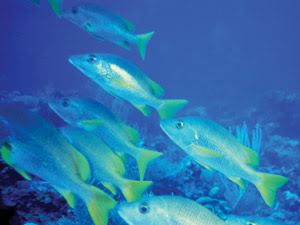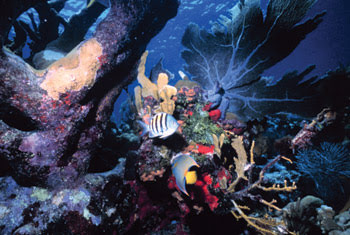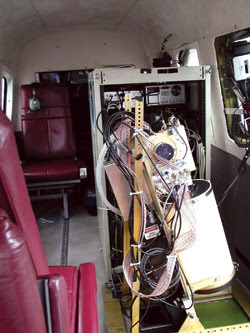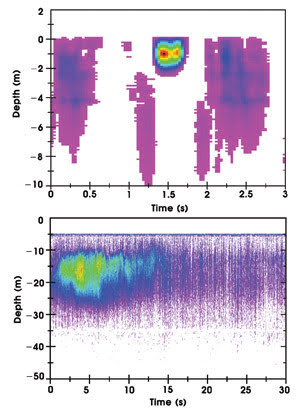Photonics technologies enable researchers to better understand the behavior of fish, helping to achieve sustainable commercial fish populations.
Brent D. Johnson, Senior News Editor
The dramatic worldwide reduction in fish populations
has put the notion of limitless ocean resources to rest. Swordfish, bluefin tuna,
Atlantic salmon and Chilean sea bass populations are under intense pressure from
the fishing industry. Even the Atlantic cod, whose stock once appeared inexhaustible,
has been pushed to the brink of disappearing as a viable commercial species.

Once considered a limitless resource, stocks of game fish must be exploited responsibly or they may disappear. Photonics is finding a place
in the assessment and management of fish populations. Courtesy of the National Oceanic and Atmospheric Administration.
Although regulators have reported some rebounds
in fish populations in recent months — attributable to the careful management
of spawning grounds — most experts agree that further study is needed to achieve
a sustainable system. But how can we perform an adequate undersea census?
One of the best methods of tracking
the numbers and types of fish has been to survey what the fishermen and trawlers
drag up in their nets. But researchers are continuing to explore new technologies,
and photonics is finding a place in monitoring the health and the behavior of fish.
A line in the sand
Churchill Grimes and Mary Yoklavich of the Southwest
Fisheries Science Center in Santa Cruz, Calif., are heading a team of researchers
in imaging the seafloor with a laser line scanner. The laser system is an optical
analog to side-scan sonar but with higher resolution, enabling the group to distinguish
species of fish and invertebrates and to link them to specific benthic habitats.
The scientists are evaluating the technique for potential applications in fisheries
management and marine ecology.
Northrop Grumman Corp.’s SM-2000
532-nm laser line scanner evolved out of the defense contractor’s mine-hunting
system. The light from the solid-state laser is projected onto a diamond-faceted
mirror that rotates on a central axle. The mirror reflects the light in a narrow
beam, reducing the backscatter that can plague underwater imaging systems. The returning
light is reflected through a prism onto a gated receiver that blocks ambient wavelengths,
yielding high-contrast light-field images at millimeter to centimeter resolution
and at two to five times the range of conventional video and photographic systems.
The investigators took the device to
Big Creek Ecological Reserve off the coast of Big Sur to determine its effectiveness
in open water. Yoklavich had previously mapped the area with sonar, so they knew
the area well. They scanned a 2 x 1-mile section of the reserve 3 to 9 m above the
seafloor for 45 hours at a speed of 2 to 3 knots. The imaged swath collected light
at an angle of about 70°, resulting in an image approximately 13 m wide.
Based on these tests, the researchers
believe that the technique has considerable potential. Grimes said that it offers
a near-photographic reproduction of the seafloor. “This technology bridges
the gap between acoustic mapping and using an occupied submersible or ROVs [remotely
operated vehicles] with camera systems, which have extremely limited spatial coverage.”
Yoklavich said that it should allow
them to assess the impact of fishing and that it offers some indication of the types
of fish present. Although it cannot distinguish one species of rockfish from another,
for example, it can differentiate some flatfish from rockfish.
“I think it’s going to
be very useful for spatial ecology,” said co-investigator Waldo Wakefield
of the Northwest Fisheries Science Center in Seattle. “You can image a significant
area of the seafloor that you couldn’t do with anything else.”

Courtesy of the National Oceanic and Atmospheric Administration.
Fishing by light
Over the past decade, James H. Churnside of the
National Oceanic and Atmospheric Administration’s Environmental Technology
Laboratory in Boulder, Colo., has been developing a lidar system for fisheries
management. He obtained the first system from the Southwest Marine Fisheries Laboratory
in La Jolla, Calif., but has since replaced almost every component.

Researchers are employing airborne lidar systems to detect, identify and monitor schools of fish.
In a series of trials in Tampa, Fla.,
the Bay of Biscay in Spain and the coastal waters of California, Churnside and
his colleagues have accurately identified lidar returns from whales and dolphins,
as well as large schools of sardines and anchovies and layers of plankton. They
flew the lidar system at an altitude of 1000 feet and recorded a 5- to 15-m-wide
swath of data. Using 15-ns-long pulses of 532-nm light from a Q-switched Nd:YAG,
it penetrated to a depth of approximately 50 m, depending on the clarity of the
water. A 20-cm refractor telescope collected the returning light, and a condenser
focused the light onto a photomultiplier tube.
Attenuation is a significant factor
in this application — at the maximum penetration depth, the signal is reduced
by four orders of magnitude. The investigators resolved this technical challenge
by incorporating a receiver with a high dynamic range. Churnside also employed
a logarithmic amplifier, which condensed the large dynamic input of the returned
signal.
Correlating their results with the
data from ships that had performed echolocation four days earlier, the team reported
a 50 percent agreement. School-by-school comparisons were better, showing a 99 percent
correlation.
Interestingly, sonar and lidar surveys
indicated that the herring population in Prince William Sound had been very low
one year, but its numbers were surveyed as normal the next. These were adult fish,
Churnside noted, so they must have gone somewhere and returned. Further investigation,
combining lidar and traditional sonar techniques, could give the researchers new
insight into the migration and feeding patterns of these creatures.

In the laser-generated echograms of schools of fish — in this case, mullet and anchovy — the intensity of the returning signal
is color-coded. The X-axis charts the time of flight of the aircraft over the linear target region.
Onboard tuna navigation
The long-term monitoring of representative individual
fish also helps investigators understand the behavior of marine populations. But
although the global positioning system may be a boon for tracking a tagged animal
on land, it is no help in determining the position of an aquatic target. Therefore,
engineers at the Centre for Environment, Fisheries & Aquaculture Science in
the UK and at Lotek in St. John’s, Newfoundland, Canada, have developed a
photonic instrument that archives geolocation data for such applications.
The 16-mm-diameter, 70-mm-long implant,
called the LTD2310, features a 2-mm-diameter flexible stalk that protrudes from
the animal into the water to measure irradiance. Wrapped in a clear fluorocarbon
sheath, the stalk features a plastic optical fiber doped with a fluorescent dye
that serves as a light collector and diffuser. Available light is captured and re-emitted
by the dye and propagates down the fiber into the body of the tag, where a silicon
photodiode directly drives a logarithmic current-to-voltage converter. This setup
achieves nine decades of intensity range.

Autonomous devices implanted into individual fish determine the
daily position of the animal by the intensity of sunlight at depth. Logs
of such information expose their migratory behavior. Courtesy of Lotek.
By combining its measurements of light
intensity and depth, the tag estimates the light at the surface of the water and
uses it to perform a high-tech version of navigating by the heavens. Using a sequence
of those surface intensities, the device deduces the times of sunrise and sunset,
with which it calculates location by latitude and longitude. Although longitudes
thus produced are satisfactory, estimates of the latitude may be supplemented and
corrected with reference to ocean surface temperature.
This and other summary data are stored
in a log that records an entry every day over a span of a decade. When the subject
fish is recaptured and the tag recovered, the investigators can reconstruct the
details of the animal’s voyage.
A fish story
Researchers in the US and Japan have implanted
several hundred units of a larger, earlier tag in fish. More than 100 have been
recovered, and the information they provide is changing our understanding of these
animals.
A tuna that was tagged and released
off the Tsushima islands between Japan and Korea was found to have moved north along
the eastern Japanese coast and to have crossed the Pacific to San Diego in two months,
much faster than the researchers had thought possible. The tuna then spent several
months wandering between Baja California, Mexico, and Oregon before it was caught,
again near San Diego.
No doubt, as technology continues to
cast light into the shadowy depths, new revelations of the behavior of sea creatures
will continue to unfold, enabling scientists to better understand how to exploit
the resources of the seas responsibly.